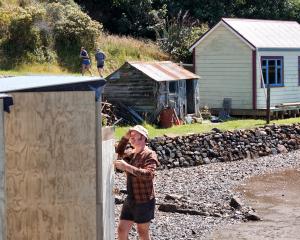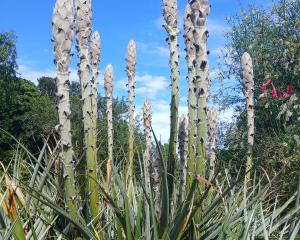An English couple have built a small, sustainable home and an idyllic lifestyle in Central Otago. Kim Dungey reports.
Julia Larkin is helping out at an artists' co-operative in Wanaka.
Out the back there are old plum trees. From a side window, she can see the lake and snow-capped mountains.
In a few hours, she will collect her children from school and drive the 15 minutes home, where husband Simon has been working in an office with picturesque views towards Hawea.
Even if there is washing up to do, she won't mind because she can scan the mountains from the sink, she says.
"In the UK, we lived in a brick house that was over 100 years old, but we ...were completely surrounded by roads, traffic and people ... So we got here and we just couldn't believe our luck."
Architectural designer Gary Todd says he nicknamed their house the winged warrior, not only because it perches on a craggy outcrop where hawks soar around the cliff faces but also because it flies the flag for sustainable design and "affordable architecture".
At the recent Architectural Designers of New Zealand Otago-Southland awards, it won the prizes for best new home under 250sq m and best use of colour.
Both graphic designers, the Larkins migrated to Auckland in 2004 and had no intention of moving south. But two and a-half years ago, they paid a flying visit to Central Otago to celebrate Mr Larkin's birthday and fell in love with the scenery.
Buying their 8ha Queensberry Hills block left them with only a $300,000 budget, so they approached several franchise builders with the idea of a simple box with lots of glass at one end to make the most of the views, Mrs Larkin says.
"But everyone wanted to build just what was in their drawings because they knew what the price was and how much the building materials would be. We were getting pretty despondent ..."
It was at that point the Larkins saw a newspaper article in which Mr Todd encouraged people on lower budgets to make more use of professional designers.
A few days later, when he visited and showed them a concept drawing, they knew they were back on track.
Midway between Cromwell and Wanaka, the rugged area was once an important staging post for travellers to the goldfields.
The elevated site with its high winds and extreme temperatures called for a single-storey home that would nestle into the surrounding kanuka bush.
But the lofty location was also an asset in that it offered sweeping views of the Clutha River basin, the Hawkdun Mountains and the ranges surrounding Lakes Hawea and Wanaka. A narrow building platform dictated the size and the shape of the house. At 170sq m, it is the smallest Mr Todd has designed. However, the winged roof soars over an efficient floor plan that comprises four bedrooms, two bathrooms, an open-plan living area and a utility/office/laundry area that can be adapted to a single garage in the future. One end of the house has a solid feel; the other is more translucent, large expanses of glass capturing the sun and views and a deck extending from the living area to the edge of the rocky outcrop.
Future energy and maintenance costs will be sustainable compared with other low-cost buildings that require a lot of painting and have inefficient heating and lighting, Mr Todd says.
The concrete floor absorbs and holds the sun's heat. The single coat of low-VOC paint that gives a whitewash effect on the plywood walls and ceilings is cheaper and greener than some alternatives. And the corrugate cladding, a traditional building material in rural areas, will last many years in an inland location.
The award judges praised the house for its harmony of form and finishes and the owners are just as enthusiastic.
Not only do they have the space around them that they always wanted, but they appreciate the open-plan lay-out and indoor-outdoor flow that are not usually found in English homes, Mrs Larkin says.
The living area is her favourite room because of its "amazing" view.
"You walk in and it still - a year and a-half down the line - takes your breath away."











